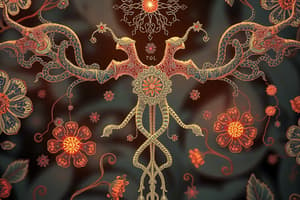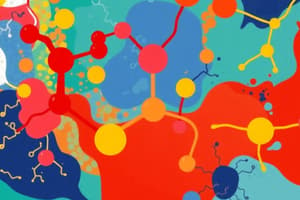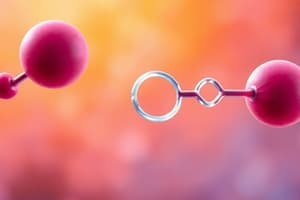Podcast
Questions and Answers
Which of the following is NOT a criterion for a chemical signal to be considered a hormone?
Which of the following is NOT a criterion for a chemical signal to be considered a hormone?
- Secreted into the blood
- Effects only at high concentrations (correct)
- Transported to a distant target
- Affects growth or metabolism
Steroid hormones are stored in secretory vesicles before release.
Steroid hormones are stored in secretory vesicles before release.
False (B)
Where are the receptors for peptide hormones located?
Where are the receptors for peptide hormones located?
On the cell surface
Catecholamines are derived from the amino acid ______.
Catecholamines are derived from the amino acid ______.
Match the type of hormone with its source or characteristics:
Match the type of hormone with its source or characteristics:
Which hormone acts by regulating gene expression?
Which hormone acts by regulating gene expression?
All amine hormones act similarly to steroid hormones.
All amine hormones act similarly to steroid hormones.
What is the role of the hypothalamus in endocrine reflexes?
What is the role of the hypothalamus in endocrine reflexes?
Peptide hormones are released by ______ when triggered.
Peptide hormones are released by ______ when triggered.
Which of the following is an example of a catecholamine?
Which of the following is an example of a catecholamine?
Which hormone primarily targets the mammary glands?
Which hormone primarily targets the mammary glands?
Adrenocorticotropic Hormone (ACTH) is controlled by gonadotropin-releasing hormone (GnRH).
Adrenocorticotropic Hormone (ACTH) is controlled by gonadotropin-releasing hormone (GnRH).
What hormone does the thyroid gland primarily respond to?
What hormone does the thyroid gland primarily respond to?
The hormone that stimulates the adrenal cortex is called ______.
The hormone that stimulates the adrenal cortex is called ______.
Match the anterior pituitary hormones with their controlling factors:
Match the anterior pituitary hormones with their controlling factors:
What is the primary action of insulin following high blood glucose levels?
What is the primary action of insulin following high blood glucose levels?
Short-loop negative feedback involves the suppression of anterior pituitary hormones directly by the target endocrine gland.
Short-loop negative feedback involves the suppression of anterior pituitary hormones directly by the target endocrine gland.
What feedback mechanism is described as the most dominant and involves peripheral endocrine glands?
What feedback mechanism is described as the most dominant and involves peripheral endocrine glands?
Low levels of calcium in the blood stimulate the release of ______.
Low levels of calcium in the blood stimulate the release of ______.
Which hormone targets the liver and promotes growth and metabolism?
Which hormone targets the liver and promotes growth and metabolism?
Flashcards
Feedback Loops
Feedback Loops
Systems that coordinate hormonal and neural responses to maintain a stable internal environment (homeostasis).
Anterior Pituitary Hormones
Anterior Pituitary Hormones
Six hormones produced by the anterior pituitary gland: Prolactin, TSH, ACTH, GH, FSH, and LH.
Prolactin (PRL)
Prolactin (PRL)
A hormone that stimulates milk production in the mammary glands.
Thyroid-Stimulating Hormone (TSH)
Thyroid-Stimulating Hormone (TSH)
Signup and view all the flashcards
Adrenocorticotropic Hormone (ACTH)
Adrenocorticotropic Hormone (ACTH)
Signup and view all the flashcards
Growth Hormone (GH)
Growth Hormone (GH)
Signup and view all the flashcards
Follicle-Stimulating Hormone (FSH)
Follicle-Stimulating Hormone (FSH)
Signup and view all the flashcards
Luteinizing Hormone (LH)
Luteinizing Hormone (LH)
Signup and view all the flashcards
Long-Loop Negative Feedback
Long-Loop Negative Feedback
Signup and view all the flashcards
Short-Loop Negative Feedback
Short-Loop Negative Feedback
Signup and view all the flashcards
Hormone Criteria
Hormone Criteria
Signup and view all the flashcards
Peptide Hormone Synthesis
Peptide Hormone Synthesis
Signup and view all the flashcards
Steroid Hormone Synthesis
Steroid Hormone Synthesis
Signup and view all the flashcards
Peptide Hormone Storage
Peptide Hormone Storage
Signup and view all the flashcards
Steroid Hormone Storage
Steroid Hormone Storage
Signup and view all the flashcards
Peptide Hormone Receptors
Peptide Hormone Receptors
Signup and view all the flashcards
Steroid Hormone Receptors
Steroid Hormone Receptors
Signup and view all the flashcards
Catecholamine Hormones
Catecholamine Hormones
Signup and view all the flashcards
Thyroid Hormones
Thyroid Hormones
Signup and view all the flashcards
Melatonin Hormone
Melatonin Hormone
Signup and view all the flashcards
Study Notes
Chemical Signals and Hormones
- Chemicals secreted into the blood by a cell travel to distant targets
- The hormone affects growth, development, homeostasis, or metabolism at very low concentrations
Peptide and Steroid Hormone Comparison
- Peptide Hormones:
- Synthesized in advance as preprohormones, then cleaved into active hormones
- Stored in secretory vesicles
- Released via exocytosis (e.g., insulin)
- Steroid Hormones:
- Synthesized on demand from cholesterol
- Not stored, released immediately after synthesis
- Diffuse through the cell membrane (e.g., cortisol)
Hormone Receptor Location and Mechanism
- Peptide Hormones:
- Receptors located on the cell surface
- Activate second messenger pathways, leading to rapid responses (e.g., insulin)
- Steroid Hormones:
- Receptors located within the cytoplasm or nucleus
- Regulate gene expression, leading to slower but longer-lasting effects (e.g., testosterone)
Amine Hormone Groups
- Catecholamines:
- Derived from tyrosine
- Act like peptide hormones (e.g., epinephrine, norepinephrine)
- Thyroid Hormones:
- Derived from two tyrosine molecules
- Act like steroid hormones (e.g., thyroxine [T4], triiodothyronine [T3])
- Melatonin:
- Derived from tryptophan
- Regulates circadian rhythms
Nervous System and Endocrine Reflexes
- The nervous system integrates with the endocrine system through neurohormones and control pathways
- Hypothalamus: Produces neurohormones regulating the pituitary gland
- Neuroendocrine Reflexes: Electrical signals trigger hormone release (e.g., oxytocin)
- Feedback Loops: Coordinate hormonal and neural responses for homeostasis
Anterior Pituitary Hormones
- Prolactin (PRL): Controlled by prolactin-releasing factors and dopamine. Targets mammary glands.
- Thyroid-Stimulating Hormone (TSH): Controlled by thyrotropin-releasing hormone (TRH). Targets thyroid gland.
- Adrenocorticotropic Hormone (ACTH): Controlled by corticotropin-releasing hormone (CRH). Targets adrenal cortex.
- Growth Hormone (GH): Controlled by growth hormone-releasing hormone (GHRH) and somatostatin. Targets liver and other tissues.
- Follicle-Stimulating Hormone (FSH): Controlled by gonadotropin-releasing hormone (GnRH). Targets gonads.
- Luteinizing Hormone (LH): Controlled by gonadotropin-releasing hormone (GnRH). Targets gonads.
Negative Feedback Loops
- Long-Loop Negative Feedback: Hormones from target endocrine glands inhibit the anterior pituitary and hypothalamus (e.g., cortisol).
- Examples: Insulin (blood glucose), Parathyroid Hormone (calcium)
- Other: Short-loop, Ultra-short-loop
Hormone Interactions
- Permissiveness: One hormone enables another's full effect (e.g., thyroid hormone and epinephrine)
- Synergism: Two hormones together produce a greater effect than their individual effects (e.g., glucagon and epinephrine on blood glucose)
- Functional Antagonism: Two hormones have opposing effects (e.g., insulin and glucagon on blood glucose)
Endocrine Pathologies
- Hypersecretion: Excess hormone production (e.g., hyperthyroidism)
- Hyposecretion: Deficient hormone production (e.g., hypothyroidism)
- Abnormal Target Response: Target cells fail to respond appropriately (e.g., type 2 diabetes)
Studying That Suits You
Use AI to generate personalized quizzes and flashcards to suit your learning preferences.
Related Documents
Description
This quiz explores the fascinating world of hormones, focusing on their chemical signals, types, and mechanisms of action. You'll learn about the differences between peptide and steroid hormones, their synthesis, and how they interact with cell receptors. Test your knowledge on how these essential substances regulate various physiological processes.




